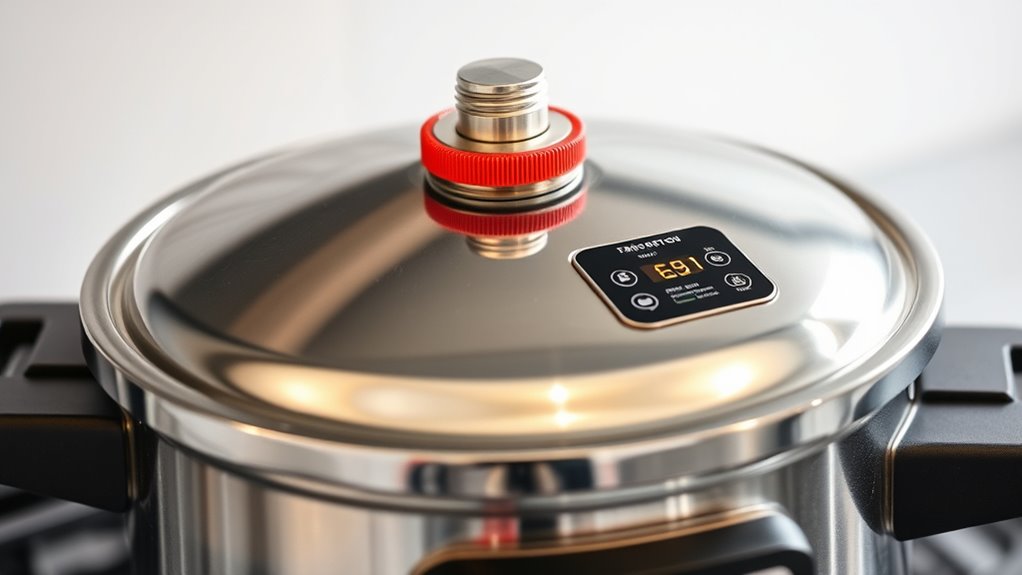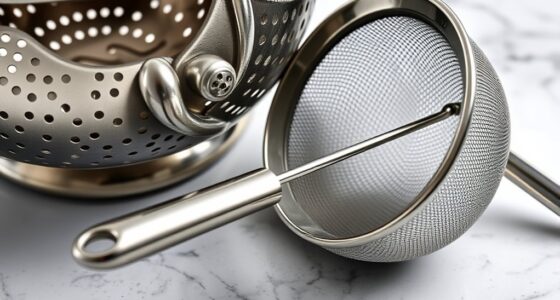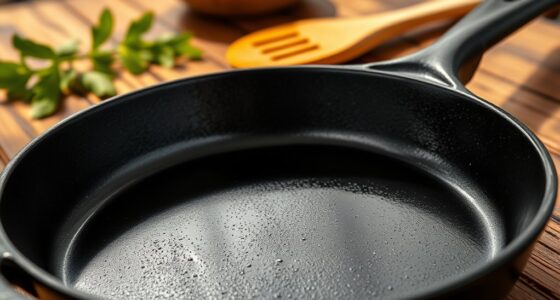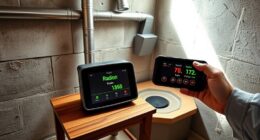To guarantee safe pressure cooker use, always check that your steam vent or valve functions properly and isn’t blocked, as this prevents dangerous pressure build-up. Inspect the sealing ring regularly, replacing it if it shows cracks or tears, to avoid steam leaks. Set the pressure to the recommended level for your recipe, and never open the lid until pressure is fully released and the indicator shows it’s safe. Continuing your guide will help you understand these steps in detail.
Key Takeaways
- Regularly check that vent pipes or valves are clean, unobstructed, and functioning properly to prevent dangerous pressure build-up.
- Inspect the sealing ring for cracks, tears, or damage; ensure it’s correctly positioned for an airtight seal.
- Set the pressure level according to the recipe and model instructions; never force the lid open during cooking.
- Keep pressure release mechanisms free of debris; perform proper depressurization before opening the cooker.
- Always verify the pressure indicator shows safe pressure and wait for complete pressure release before lid removal.
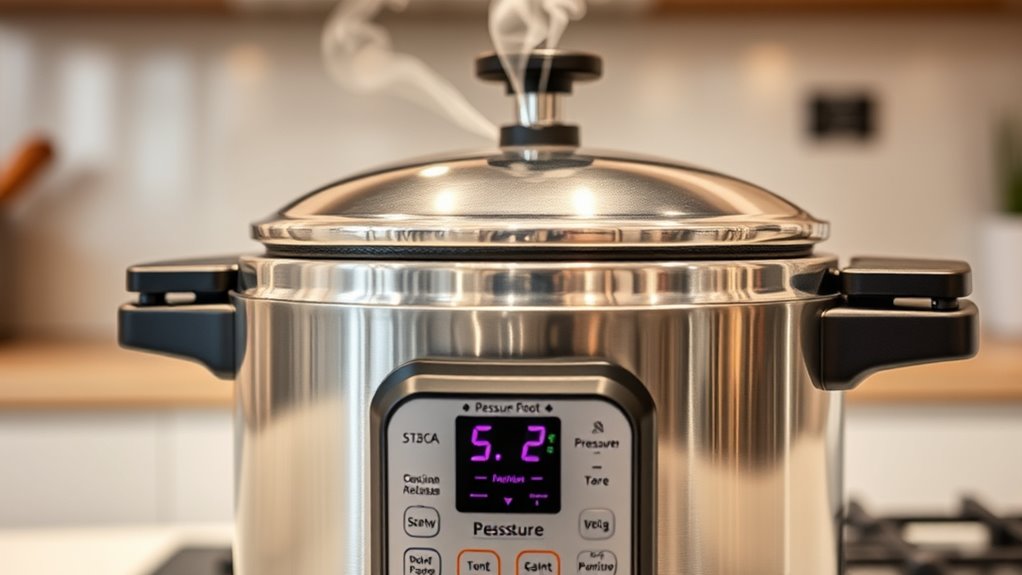
Using a pressure cooker can save you time and lock in flavor, but it’s vital to prioritize safety to prevent accidents. The key to safe pressure cooking lies in understanding how steam, seals, and settings work together. First, ensure the steam release mechanisms are functioning properly. Most pressure cookers have a vent pipe or valve that allows excess steam to escape safely. Before you start cooking, check that this vent isn’t clogged or blocked, as this could cause dangerous pressure build-up. Always use fresh, clean water and make sure the valve moves freely. If you notice any damage or if the vent is stuck, don’t use the cooker until it’s repaired or replaced.
Next, pay close attention to the sealing ring, which creates the airtight environment needed for pressure. The rubber or silicone gasket must be in good condition—flexible, free of cracks, and properly positioned. A worn or damaged seal can lead to steam leaks, which not only compromise cooking efficiency but also pose safety risks. Regularly inspect the sealing ring before each use, and replace it if you notice any deterioration. Proper placement is vital; ensure it sits evenly in its groove to prevent steam from escaping around the edges.
Understanding and setting the correct pressure level is equally important. Most pressure cookers have adjustable settings, often labeled as low, medium, and high. Refer to your specific model’s manual to determine the appropriate setting for your recipe. Using the wrong setting can result in undercooked food or excessive pressure buildup. Once you lock the lid in place, turn on the heat and wait for the cooker to reach the desired pressure. You’ll usually hear a hissing sound or see a pressure indicator rise, confirming that it’s working correctly. Never force the lid open during cooking, especially if you suspect high pressure inside. Always wait until the pressure has been fully released.
Proper maintenance of the pressure cooker’s pressure release mechanisms and ensuring they are free of debris or blockages is essential for safety. When cooking, keep an eye on the pressure indicator and the steam release. If at any point you notice irregular steam or hear hissing louder than usual, turn off the heat immediately. After cooking, follow proper depressurization procedures—either natural release or quick release—based on your recipe. Never attempt to open the lid until the pressure indicator shows that it’s safe and the cooker has cooled down sufficiently. By paying attention to these details—steam release, seal integrity, and proper settings—you’ll guarantee that your pressure cooking remains safe, efficient, and enjoyable.
Frequently Asked Questions
How Often Should I Replace the Pressure Cooker Seals?
You should replace your pressure cooker seals every 12 to 18 months, or sooner if you notice cracks, tears, or leaks. Regularly inspect the seal for signs of wear, as a worn-out seal can compromise safety and performance. Proper maintenance guarantees your cooker operates safely and efficiently. Always follow the manufacturer’s recommendations for replacement intervals and replace seals promptly to avoid accidents or cooking issues.
Can I Open the Pressure Cooker Immediately After Cooking?
Think of your pressure cooker as a volcano waiting to erupt. You shouldn’t open it immediately after cooking because the built-up steam is like bubbling lava. Wait until the pressure drops and the safety valve releases, signaling it’s safe. This prevents burns or accidents. Patience lets the “lava” settle, ensuring you open the lid safely, just as a volcano calms before you approach it.
What Is the Ideal Pressure Setting for Different Recipes?
For most recipes, set your pressure cooker to 10-12 psi for high-pressure cooking and 6-8 psi for low-pressure dishes. Use the high setting for tougher meats and beans, and the low setting for delicate foods like vegetables and seafood. Always follow your recipe’s specific instructions, as some dishes require different pressure levels. Adjust the pressure based on the desired cooking time and texture.
How Do I Troubleshoot Steam Leaks During Cooking?
Did you know that nearly 60% of pressure cooker accidents are caused by steam leaks? To troubleshoot leaks during cooking, first, turn off the cooker and let it cool. Inspect the sealing ring for cracks or debris, and make certain it’s properly seated. Check the steam vent for blockages and tighten the lid securely. Reassemble everything carefully before restarting to prevent dangerous leaks and guarantee safe cooking.
Are There Safety Differences Between Electric and Stovetop Pressure Cookers?
Yes, electric and stovetop pressure cookers have safety differences. Electric models often include automatic pressure and temperature controls, safety locks, and built-in sensors that monitor conditions continuously. Stovetop cookers rely more on manual operation and your judgment. Electric cookers are generally considered safer for beginners because they handle more safety features automatically, reducing the risk of accidents caused by improper pressure release or over-pressurization.
Conclusion
Remember, a pressure cooker is a powerful tool—if used correctly. Always check your seals, venting, and settings before cooking. One small oversight could lead to unexpected steam bursts or accidents. Stay alert, follow safety guidelines, and never leave it unattended while in use. The next time you hear that pressurized hiss, ask yourself: are you truly prepared? Because when it comes to pressure cooker safety, a moment’s caution can make all the difference—don’t risk it.
